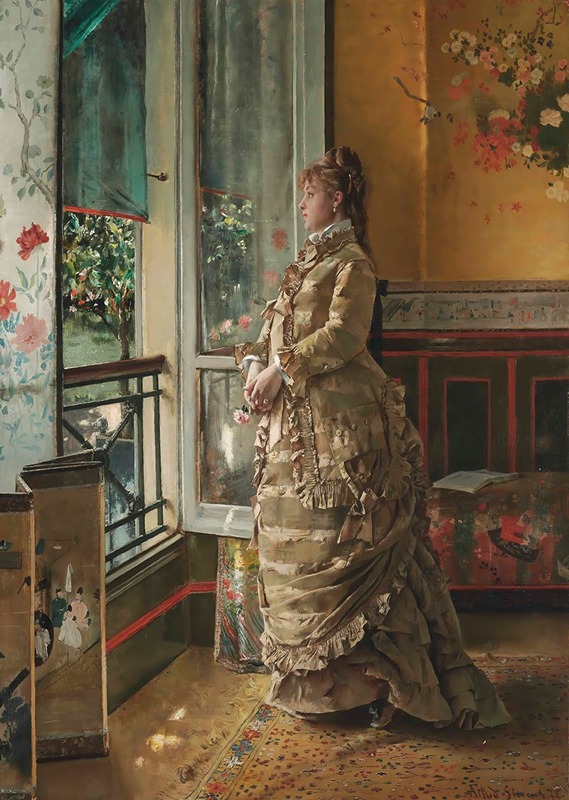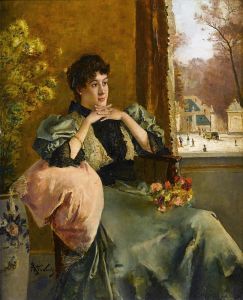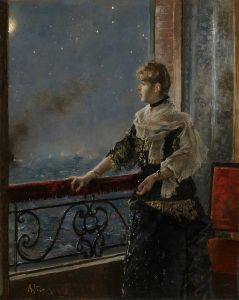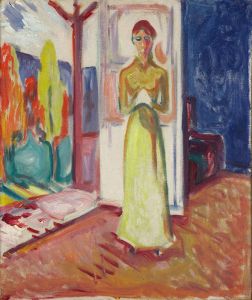
Mélancolie
A hand-painted replica of Alfred Stevens’s masterpiece Mélancolie, meticulously crafted by professional artists to capture the true essence of the original. Each piece is created with museum-quality canvas and rare mineral pigments, carefully painted by experienced artists with delicate brushstrokes and rich, layered colors to perfectly recreate the texture of the original artwork. Unlike machine-printed reproductions, this hand-painted version brings the painting to life, infused with the artist’s emotions and skill in every stroke. Whether for personal collection or home decoration, it instantly elevates the artistic atmosphere of any space.
Alfred Stevens, a renowned Belgian painter, created the artwork "Mélancolie" in the 19th century. Stevens was born on May 11, 1823, in Brussels, Belgium, and he became one of the most celebrated artists of his time, particularly known for his depictions of elegant women in luxurious settings. His works often reflect the social and cultural milieu of the bourgeoisie during the Belle Époque.
"Mélancolie," which translates to "Melancholy" in English, is a poignant example of Stevens' ability to capture the emotional depth and complexity of his subjects. The painting portrays a young woman seated in an opulent interior, her posture and expression conveying a sense of deep contemplation or sorrow. The exact date of the painting is not definitively known, but it is believed to have been created during the height of Stevens' career in the latter half of the 19th century.
The composition of "Mélancolie" is meticulously crafted, with Stevens' characteristic attention to detail evident in the rendering of the woman's attire and the surrounding environment. The use of light and shadow enhances the mood of the painting, drawing the viewer's eye to the woman's face and the subtle nuances of her expression. The luxurious fabrics and furnishings in the background further emphasize the contrast between the external opulence and the internal emotional state of the subject.
Stevens' technique in "Mélancolie" showcases his mastery of color and texture. The soft, muted palette contributes to the overall melancholic atmosphere, while the delicate brushwork highlights the intricate details of the woman's dress and the textures of the various materials depicted. This attention to detail is a hallmark of Stevens' work, reflecting his training and influences from both the Belgian and French art scenes.
Alfred Stevens was influenced by the Realist movement, and his works often contain elements that reflect the social realities of his time. However, "Mélancolie" transcends mere social commentary, offering a more introspective and personal exploration of human emotion. The painting invites viewers to ponder the inner life of the subject, creating a sense of empathy and connection.
Throughout his career, Stevens received numerous accolades and was highly regarded by his contemporaries. He exhibited regularly at the Paris Salon and was awarded several prestigious honors, including the Legion of Honor in France. His works were collected by prominent figures and institutions, cementing his reputation as a leading artist of his era.
"Mélancolie" remains an important work within Stevens' oeuvre, exemplifying his skill in capturing the subtleties of human emotion and the elegance of his subjects. The painting continues to be appreciated for its artistic merit and its ability to evoke a deep emotional response from viewers.
Alfred Stevens passed away on August 24, 1906, in Paris, but his legacy endures through his contributions to the art world. "Mélancolie" stands as a testament to his talent and his unique ability to blend realism with a profound sensitivity to the human condition.


















